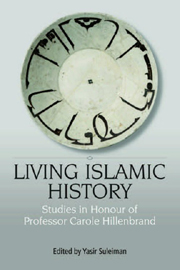Book contents
- Frontmatter
- Contents
- Acknowledgements
- Professor Carole Hillenbrand: List of Publications
- Preface
- 1 The Origin of Key Shi‘ite Thought Patterns in Islamic History
- 2 Additions to The New Islamic Dynasties
- 3 Al-Tha‘alibi's Adab al-muluk, a Local Mirror for Princes
- 4 Religious Identity, Dissimulation and Assimilation: the Ismaili Experience
- 5 Saladin's Pious Foundations in Damascus: Some New Hypotheses
- 6 The Coming of Islam to Bukhara
- 7 A Barmecide Feast: the Downfall of the Barmakids in Popular Imagination
- 8 The History of the Patriarchs of the Egyptian Church as a Source for the History of the Seljuks of Anatolia
- 9 Genealogy and Exemplary Rulership in the Tarikh-i Chingiz Khan
- 10 Vikings and Rus in Arabic Sources
- 11 Qashani and Rashid al-Din on the Seljuqs of Iran
- 12 Exile and Return: Diasporas of the Secular and Sacred Mind
- 13 Clerical Perceptions of Sufi Practices in Late Seventeenth-Century Persia, II: Al-Hurr al-‘Amili (d. 1693) and the Debate on the Permissibility of Ghina
- 14 On Sunni Sectarianism
- 15 The Violence of the Abbasid Revolution
- 16 Nationalist Poetry, Conflict and Meta-linguistic Discourse
- Bibliography
- List of Contributors
- Index
13 - Clerical Perceptions of Sufi Practices in Late Seventeenth-Century Persia, II: Al-Hurr al-‘Amili (d. 1693) and the Debate on the Permissibility of Ghina
Published online by Cambridge University Press: 12 September 2012
- Frontmatter
- Contents
- Acknowledgements
- Professor Carole Hillenbrand: List of Publications
- Preface
- 1 The Origin of Key Shi‘ite Thought Patterns in Islamic History
- 2 Additions to The New Islamic Dynasties
- 3 Al-Tha‘alibi's Adab al-muluk, a Local Mirror for Princes
- 4 Religious Identity, Dissimulation and Assimilation: the Ismaili Experience
- 5 Saladin's Pious Foundations in Damascus: Some New Hypotheses
- 6 The Coming of Islam to Bukhara
- 7 A Barmecide Feast: the Downfall of the Barmakids in Popular Imagination
- 8 The History of the Patriarchs of the Egyptian Church as a Source for the History of the Seljuks of Anatolia
- 9 Genealogy and Exemplary Rulership in the Tarikh-i Chingiz Khan
- 10 Vikings and Rus in Arabic Sources
- 11 Qashani and Rashid al-Din on the Seljuqs of Iran
- 12 Exile and Return: Diasporas of the Secular and Sacred Mind
- 13 Clerical Perceptions of Sufi Practices in Late Seventeenth-Century Persia, II: Al-Hurr al-‘Amili (d. 1693) and the Debate on the Permissibility of Ghina
- 14 On Sunni Sectarianism
- 15 The Violence of the Abbasid Revolution
- 16 Nationalist Poetry, Conflict and Meta-linguistic Discourse
- Bibliography
- List of Contributors
- Index
Summary
The anti-Sufi polemic that marked Iran's spiritual discourse during the seventeenth century was no mere esoteric discussion. While visible during the century following the 1501 establishment of Twelver Shi‘ism by the Safavid dynasty as the realm's official faith, beginning in the seventeenth century attacks on Sufism and, increasingly, on such alleged Sufi practices as singing (ghina), were a marked feature of the religious landscape. Indeed, scholars who arrived in Iran beginning in the middle years of the second Safavid century faced a well-developed anti-Sufi discourse that had already erupted out of the mosque/madrasa, as it were, into the street. Shaykh ‘Ali b. Muhammad, al-‘Amili (d. 1691–2) and Muhammad Tahir (d. 1687), both of whom arrived in Iran from the Arab West during the reign of Shah Safi (reg. 1629–42), became active participants in the anti-Sufi campaign, charging Sufi elements, past and – especially – present with the most extreme, heretical beliefs and practices (see Newman 1999a, 1999b, 2006).
By contrast, Muhammad b. al-Hasan, al-Hurr al-‘Amili (d. 1693), who arrived in Iran in the early 1660s and is best-known as compiler of the multi-volume hadith collection Wasa ’il al-shi ‘a, avoided open identification with the worst excesses of the anti-Sufi discourse. Al-Hurr's interest in the hadith, his commencement of Wasa‘il in these same years and his decision to settle in Khurasan, far from the Safavid capital of Esfahan – the apparent home of the worst excesses of the anti-Sufi campaign – further encouraged, and were encouraged by, the manner in which he chose to participate in the anti-Sufi polemic.
- Type
- Chapter
- Information
- Living Islamic HistoryStudies in Honour of Professor Carole Hillenbrand, pp. 192 - 208Publisher: Edinburgh University PressPrint publication year: 2010



